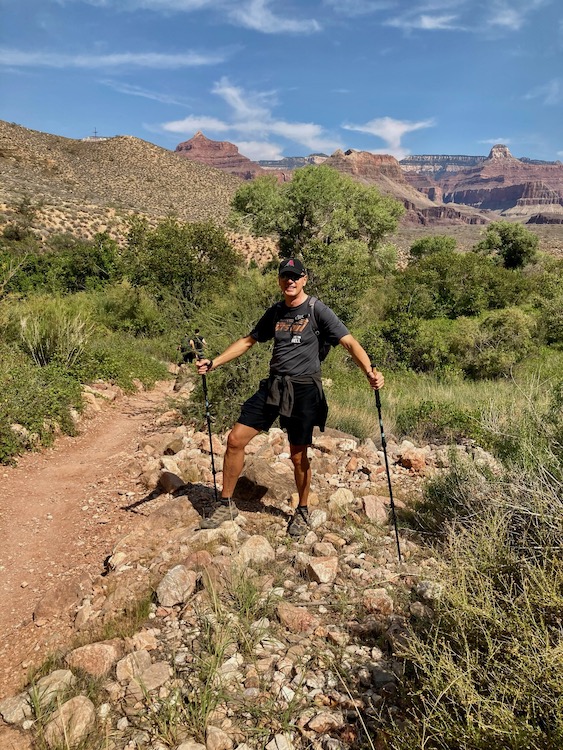posted: September 25, 2021
tl;dr: Quadrupeds have more fun...
In preparation for a hike into Grand Canyon my wife took the initiative to purchase us some inexpensive, fully adjustable hiking poles. I was somewhat skeptical, thinking that they were primarily for older hikers; I wasn’t quite ready to put myself in that category. Yet by observing others, it became clear that they were being used by hikers of all ages, so I dropped my objections. We didn’t do a trial run with them: the first time we used them was on a roundtrip hike from Grand Canyon’s South Rim to Indian Garden (being renamed “Havasupai Garden”) and back along the Bright Angel Trail.
After sixty seconds I became a huge fan, and now I am penning this testimonial. It’s a classic case of “why didn’t I do this sooner?” I’d estimate that they make hiking a difficult trail both 15% easier and 15% more enjoyable. They effectively turn a human hiker from a biped into a quadruped, on par with the other animal species which traverse the same trails. I’ve now also used them on a stream hike, the West Fork Oak Creek Trail near Sedona, Arizona, and they bring benefits on any trail, wet or dry, with elevation change and unstable, varying terrain.
Ski poles can easily substitute for hiking poles in a pinch, although being able to adjust the length of hiking poles creates a more comfortable fit for both primarily uphill (shorter poles) and downhill (longer poles) hikes. I’ve used ski poles for decades, for both alpine (downhill) and Nordic (cross-country) skiing. When using the hiking poles I often found myself performing similar maneuvers with the poles and my body weight, this time without long planks attached to my feet.

Yours truly on his first hike with hiking poles, on the Bright Angel Trail in Grand Canyon
Here are the main benefits of hiking poles:
Visual aid
I wasn’t anticipating this benefit: the poles provide physical sensory input as to the precise elevation of the next step up or down. This decreases the reliance upon the eyes to determine how to perform the next step forward. I found myself not having to stare as intently at the ground immediately ahead, so that I could spend a bit more time looking around and even enjoying the surroundings while still in motion. I should have expected that the poles would help my body determine where next to step, as some blind people are able to navigate city streets and buildings by probing the territory ahead of them with a pole or stick.
Better balance
This is the primary benefit I was anticipating: using the hiking poles produces better balance by allowing you to correct body position before leaning far over. This process happens automatically, without conscious thought. I simply found myself staying upright better, with fewer occurrences of having to catch myself before a fall.
Better stability
Without poles, when you lift one leg for the next step ahead, your body weight is momentarily supported by just one leg, on perhaps unstable ground. You probably cannot hold this position for too long before having to put down your other foot. With hiking poles, however, when you lift one leg, you are still supported via three different points of contact with the ground. This is the minimum number of contact points for a stable stool, chair, or table: you can probably hold this position for quite a long time. Thanks to the stability provided by the poles, you can use this additional time to make a better decision on where to step next.
Bigger steps
The better balance and stability allow you to take bigger steps across tricky terrain, such as wobbly, wet stones at a stream crossing. This makes it easier and faster to traverse challenging sections of the trail. There were very few people on the stream hike with poles, and several times pole-less hikers would watch me quickly scamper across the stream on slippery, wobbly rocks, without getting my feet wet.
Arresting falls
Most of the time, the hiking poles aren’t supporting much body weight: the legs still do almost all the work. But there are occasions when you may find yourself putting significant weight on one or both poles: when you slip or lose your footing. Poles decrease the chances of this happening, but when it does, the poles can help arrest a fall.
I won’t be using poles on all the hikes I take in the future, but I will definitely be using them on the more challenging hikes. I highly recommend them.